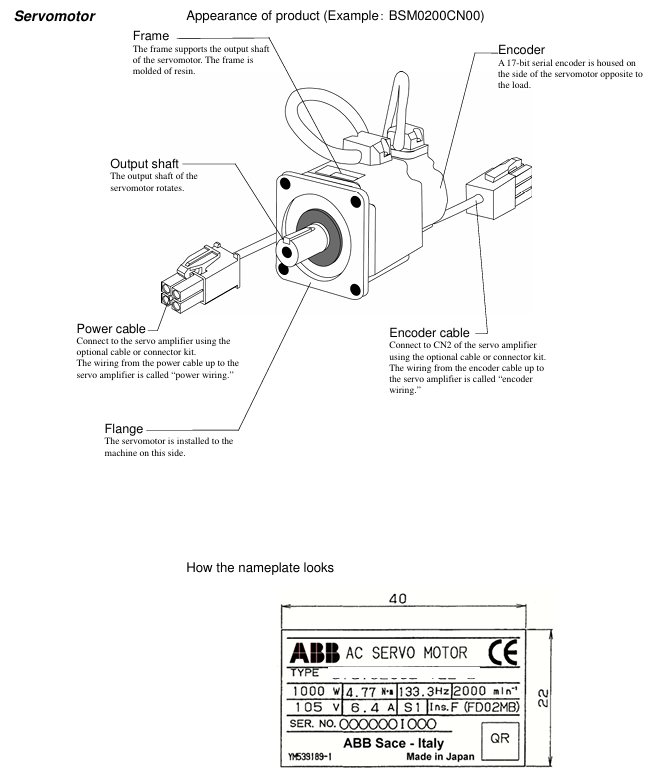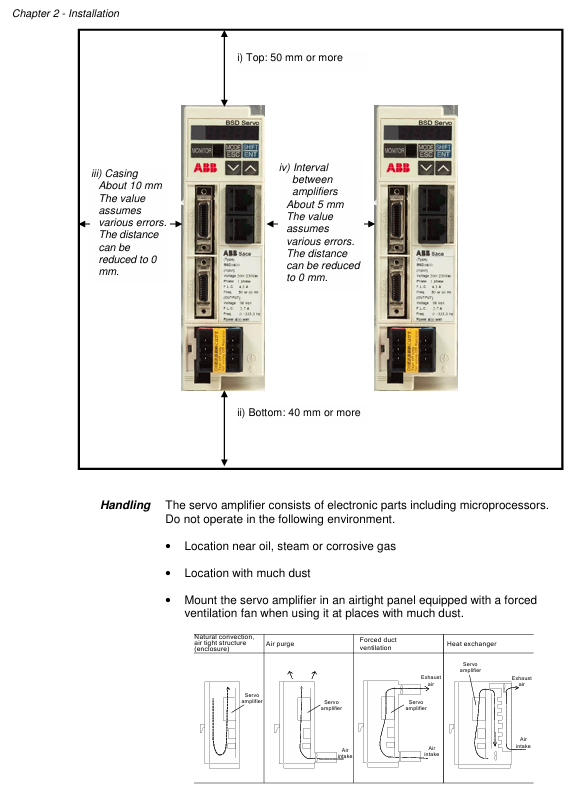ABB Sace BSD series brushless servo drive
ABB Sace BSD series brushless servo drive
Equipment Overview
1. Specification of servo amplifier
Model Applicable Motor Capacity Power Type Key Parameters
BSD0100 BSM0100 (100W) single-phase 200-230V carrier frequency 10kHz, overload capacity 300%/about 3 seconds
BSD0200 BSM0200 (200W) single-phase 200-230V-
BSD0400 BSM0400 (400W) single-phase 200-230V-
BSD0750 BSM0750 (750W) single-phase/three-phase 200-230V-
BSD1000 BSM1000 (1000W) three-phase 200-230V-
BSD1500 BSM1500 (1500W) three-phase 200-230V-
BSD2000 BSM2000 (2000W) three-phase 200-230V-
2. Specification of servo motor
Series model Capacity Rated speed Rated torque Encoder
Low inertia BSM0100 100W 3000r/min 0.318N · m 17 bit serial
Low inertia BSM0200 200W 3000r/min 0.637N · m 17 bit serial
Low inertia BSM0400 400W 3000r/min 1.27N · m 17 bit serial
Low inertia BSM0750 750W 3000r/min 2.39N · m 17 bit serial
Medium inertia BSM1000 1000W 2000r/min 4.77N · m 17 bit serial
Medium inertia BSM1500 1500W 2000r/min 7.16N · m 17 bit serial
Medium inertia BSM2000 2000W 2000r/min 9.55N · m 17 bit serial
3. Model coding rules
Servo amplifier: Only specify power, such as the power corresponding to "XXXX" in "BSDXXXX" (0100=100W).
Servo motor: format is "BSMXXXXXX", where "XXXX"=power, "C"=shaft type (C=keyway, L=flat shaft), "N/B"=brake (N=none, B=present), "00/01"=option (00=none, 01=oil seal).
Installation requirements
1. Installation of servo motor
Project Requirements Remarks
Storage environment temperature -20 ° C~60 ° C, humidity 10% -90% RH (no condensation), the same requirement applies when equipped with gear heads
Working environment temperature -10 ° C~40 ° C, humidity 10% -90% RH (no condensation), temperature with gear head 0 ° C~40 ° C
The installation direction can be horizontal, downward, or upward (in accordance with IEC standards IMB5/L51, etc.), and the encoder end should not be subjected to force
Load limit radial load (127N-510N), axial load (19N-253N) refer to Table 2-5 in the document, such as BSM0100 radial 127N
Cable protection for mobile scenarios requires drag chains with a maximum bending radius to avoid oil/water immersion
2. Installation of servo amplifier
Project Requirements Remarks
Storage environment temperature -20 ° C~85 ° C, humidity 10% -90% RH (no condensation), altitude ≤ 1000m, no dust/corrosive gas
Working environment temperature -10 ° C~55 ° C, humidity 10% -90% RH (no condensation), non drip/dust-proof, multiple installations require spacing
Installation direction Upright direction (horizontal marked with "BSD") Heat dissipation requirements
When the installation spacing is ≥ 50mm at the top and ≥ 40mm at the bottom, and the spacing between multiple parallel units is ≥ 5mm and < 5mm, the rating needs to be reduced to 80% ED
Leave ≥ 70mm (for easy operation) for wiring in the front space, with a depth of 165mm for 1.0kW and below, and 185mm for 1.5kW and above

Wiring specifications
1. Power wiring
Equipment power type, wiring terminal voltage range, frequency
Servo amplifier (0.4kW and below) single-phase L1, L2 200-230VAC (-10%~+10%) 50/60Hz
Servo amplifier (0.75kW) single-phase/three-phase L1, L2 (single-phase); L1, L2, L3 (three-phase) 200-230VAC (single-phase -10%~+10%, three-phase -15%~+10%) 50/60Hz
Servo amplifier (0.85kW and above) three-phase L1, L2, L3 200-230VAC (-15%~+10%) 50/60Hz
Control power supply (all models) single-phase sL1, sL2 200-230VAC (-10%~+10%) 50/60Hz
2. Key wiring taboos
Do not connect the commercial power supply (200V) to the U/V/W terminals of the servo motor (as it may burn the motor).
Do not connect the grounding wire (E) to the U/V/W terminal, and do not connect the U/V/W terminal in reverse (which may cause fire/malfunction).
It is prohibited to conduct voltage withstand, megaohm, and buzzing tests on the encoder terminal (CN2) as it may damage the encoder.
The distance between the serial I/O (CN1) and the motor power cable should be ≥ 10cm (to avoid interference).
Test Run
1. Three stage testing process
Key inspection items for stage testing content
The first stage servo amplifier and motor are tested separately (not connected to the machine). 1. Power wiring (L1/L2/L3); 2. Motor power supply (U/V/W) and encoder wiring; 3. Motor rotation direction (parameter # 04); 4. No alarm
In the second stage, connect to the upper control system (not connected to the machine). 1. Connect the signal lines of the upper system; 2. I/O signals (such as emergency stop EMG, overtravel ± OT); 3. Motor speed/torque (in accordance with instructions)
The third stage of testing after installing the machine (final state): 1. The firmness of the motor installation; 2. Machine travel; 3. Servo parameter adjustment (refer to Chapter 6); 4. Positioning accuracy
2. Origin regression requirements
After power failure and restart, the motor needs to be rotated at a speed of ≤ 100r/min for 372 ° or more (approximately 1.04 rpm) in order to correctly detect the Z-phase.

Parameter settings
1. Parameter configuration method
Keyboard operation: Switch to "Parameter Editing Mode" (PnO) for settings through a 4-digit 7-segment LED display and 4 buttons (MODE/ESC, SHIFT, ENT, ∧/∨).
- EMERSON
- Honeywell
- CTI
- Rolls-Royce
- General Electric
- Woodward
- Yaskawa
- xYCOM
- Motorola
- Siemens
- Rockwell
- ABB
- B&R
- HIMA
- Construction site
- electricity
- Automobile market
- PLC
- DCS
- Motor drivers
- VSD
- Implications
- cement
- CO2
- CEM
- methane
- Artificial intelligence
- Titanic
- Solar energy
- Hydrogen fuel cell
- Hydrogen and fuel cells
- Hydrogen and oxygen fuel cells
- tyre
- Chemical fiber
- dynamo
- corpuscle
- Pulp and paper
- printing
- fossil
- FANUC
- Food and beverage
- Life science
- Sewage treatment
- Personal care
- electricity
- boats
- infrastructure
- Automobile industry
- metallurgy
- Nuclear power generation
- Geothermal power generation
- Water and wastewater
- Infrastructure construction
- Mine hazard
- steel
- papermaking
- Natural gas industry
- Infrastructure construction
- Power and energy
- Rubber and plastic
- Renewable energy
- pharmacy
- mining
- Plastic industry
- Schneider
- Kongsberg
- NI
- Wind energy
- International petroleum
- International new energy network
- gas
- WATLOW
- ProSoft
- SEW
- wind
- ADVANCED
- Reliance
- YOKOGAWA
- TRICONEX
- FOXBORO
- METSO
- MAN
- Advantest
- ADVANCED
- ALSTOM
- Control Wave
- AB
- AMAT
- STUDER
- KONGSBERG
- MOTOROLA
- DANAHER MOTION
- Bently
- Galil
- EATON
- MOLEX
- Triconex
- DEIF
- B&W
- ZYGO
- Aerotech
- DANFOSS
- KOLLMORGEN
- Beijer
- Endress+Hauser
- MOOG
- KB
- Moxa
- Rexroth
- YAMAHA
- Johnson
- Westinghouse
- WAGO
- TOSHIBA


Email:wang@kongjiangauto.com
























































































































